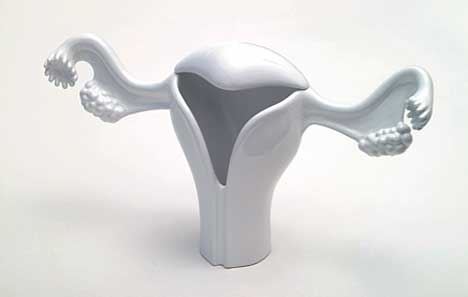Guest Post by Moira Howes, Trent University

Uterus Vase by The Plug and Stephanie Rollin
Over thirty years ago, Roger V. Short argued that regular menstrual cycling is probably a health hazard and thus, we should try to “keep the ovaries and the female reproductive tract in a state of quiescence when reproduction is not desired” [1]
More recently, Timothy Rowe, Head of Reproductive Endocrinology & Infertility, University of British Columbia, claims that “the pill keeps a woman’s reproductive organs quiet and healthy”[2]
As a philosopher of science, I find the concept of a “quiescent” bodily organ fascinating, troubling and great fodder: there is nothing so tempting to a philosopher of science as a vague, unscientific and value-laden concept.
Short and Rowe use the concept of “quiescence” to describe a presumably defined state of the uterus, but the concept is vague. It’s also unscientific—it calls to mind the promises made for “stimulated” immune systems and “cleansed” livers at my local health food store. And, the quiescent uterus raises old value-laden associations between women and passivity. If the dormant, quiet, and weak uterus is healthy, is the active, energetic, and strong uterus unhealthy?
The quiescent concept also connects temptingly with another problematic concept: “incessant ovulation.”
Short refers to regular ovulation as “incessant ovulation” and an “incessant ovulation theory” has emerged in the last decade or so. Strictly speaking, “incessant” just means “uninterrupted.” But it has negative connotations that the terms “uninterrupted” and “regular” do not. We would not say “incessant ovulation is important for bone health,” but we would say that “regular ovulation is important for bone health.” Ovulation has been described as hard work and as causing wear and tear on the ovaries. Interestingly, we do not talk of spermatogenesis in terms of incessant activity, hard work, or wear and tear: the more prolific the testicular activity, the more energetic, virile and healthy the testicle.
A more specific reason I find the term “quiescent uterus” fascinating concerns my interest in the field of reproductive immunology. Surprisingly little work has been done on the immune defences of the human female reproductive and genital tracts (though immunologists like Alison Quayle, Charles Wira and John Fahey are starting to rectify matters).
Because relatively little is known about mucosal immune defences in the human female reproductive and genital tract—and about how the reproductive immune system also contributes to blood vessel development in the uterus, ovulation, construction of the maternal-fetal interface, and the growth and development of the fetus (to name a few of the more recently discovered immune activities)—it is easy to assume that the uterus just “does nothing” when it is not involved in reproduction. Taking into account these immunological activities, however, it is clear that the reproductive tract does things besides ovulate and gestate fetuses.
What happens immunologically when women take hormonal forms of contraception?
Are the immunological activities of the uterus “quieted” and thus improved? Or are they disrupted and unhealthy?
From an immunological perspective—not to mention social and other medical perspectives—I am concerned that the notion of quiescence may stall research and pose risks to women’s health.
I’d love to hear other ideas about the quiescent uterus.
[1] Short 1976, The Evolution of Human Reproduction. Proc R Soc Lond B 195, 21
[2] “Fertility: From Foe to Friend,” Kate Rae, Glow Magazine, November 2009, 68


This reminds me of Emily Martin’s work on how medical textbooks describe the activities of the egg and the sperm. I might actually take issue with the word “regular” as well — what is “regular” anyway? Who gets to define what’s “regular”? Women themselves? Not usually.
That’s a great point Heather – “regular” is problematic too. The idea of incessant ovulation probably emerges from the idea of regular ovulation, i.e., the idea that in “healthy” women, ovulation occurs approximately every month. I gather that it is commonplace for healthy, fertile women to have anovulatory cycles — but that we don’t have much information about this given longstanding assumptions about regularity!
A quiescent uterus, besides being passive, almost seems to go back to the idea that a healthy uterus needs to be and is controlled. Most likely by some male doctor. Not necessarily a gendered problem here, but I think this also goes in with our societies love for the end result, but hatred for the process.